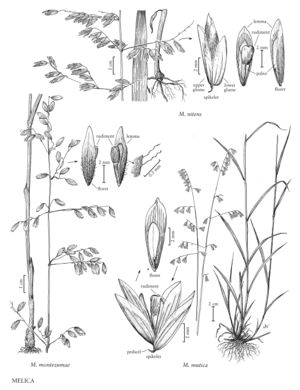Difference between revisions of "Melica montezumae"
FNA>Volume Importer |
imported>Volume Importer |
||
| (7 intermediate revisions by 2 users not shown) | |||
| Line 26: | Line 26: | ||
-->{{#Taxon: | -->{{#Taxon: | ||
name=Melica montezumae | name=Melica montezumae | ||
| − | |||
|authority=Piper | |authority=Piper | ||
|rank=species | |rank=species | ||
| Line 33: | Line 32: | ||
|basionyms= | |basionyms= | ||
|family=Poaceae | |family=Poaceae | ||
| + | |illustrator=Linda Ann Vorobik | ||
| + | |illustration copyright=Utah State University | ||
|distribution=Tex. | |distribution=Tex. | ||
|reference=None | |reference=None | ||
| Line 38: | Line 39: | ||
|publication year= | |publication year= | ||
|special status= | |special status= | ||
| − | |source xml=https:// | + | |source xml=https://bitbucket.org/aafc-mbb/fna-data-curation/src/200273ad09963decb8fc72550212de541d86569d/coarse_grained_fna_xml/V24/V24_126.xml |
|subfamily=Poaceae subfam. Pooideae | |subfamily=Poaceae subfam. Pooideae | ||
|tribe=Poaceae tribe Meliceae | |tribe=Poaceae tribe Meliceae | ||
Latest revision as of 17:22, 11 May 2021
Plants cespitose, not rhizomatous. Culms 14-100 cm, not forming corms; internodes smooth. Sheaths glabrous or scabrous; ligules 2.5-7 mm; blades 1.2-3 mm wide, abaxial surfaces glabrous, scabridulous, adaxial surfaces puberulent. Panicles 5-25 cm; branches 1-5 cm, appressed to reflexed, straight, with 2-9 spikelets; pedicels sharply bent below the spikelets; disarticulation below the glumes. Spikelets 6-8 mm, with 1 bisexual floret. Lower glumes 5.5-8 mm long, 1.8-3 mm wide, 5-veined; upper glumes 5-8 mm long, 0.7-1.5 mm wide, 3-5-veined; lemmas 4.5-8 mm, 9-15-veined, veins prominent, tuberculate, proximal portion with flat, twisted hairs, distal portion glabrous, chartaceous, apices emarginate to acute, unawned; paleas about 3/4 the length of the lemmas; anthers 1.5-3 mm; rudiments 2-3 mm, obovoid or obconic, clublike, not resembling the bisexual florets. 2n = 18.
Discussion
Melica montezumae grows primarily in shady locations in the mountains of western Texas and adjacent Mexico.
Selected References
None.
